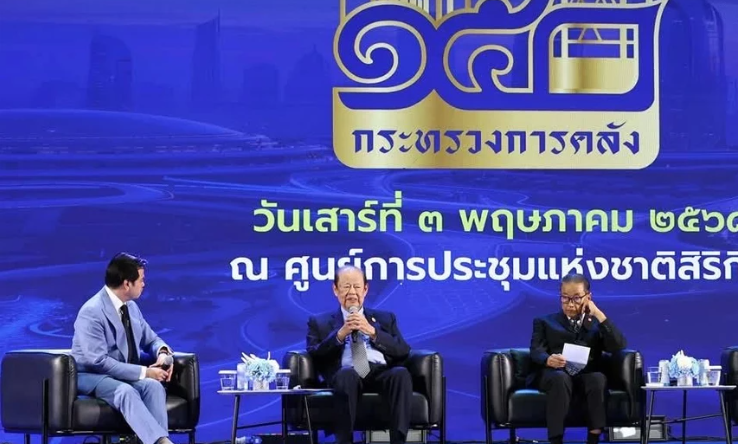Thailand’s Finance Ministry is taking new steps to steer the country through ongoing economic challenges. Former and current top officials came together on Saturday at the Queen Sirikit National Convention Centre in Bangkok. They shared lessons from the past and gave ideas for the future during the “MOF Journey: 150 Years of Thai Fiscal Development” event.
The event offered a deep look into how Thailand has handled past financial crises and how it plans to prepare for new ones. From international loans in the 1960s to pandemic relief in recent years, the Ministry’s journey reflects decades of change.
Learning from the Past: Key Moments in Thai Fiscal Policy
Aran Thammano, a former permanent secretary, explained that Thailand began borrowing from global lenders like the World Bank and the IMF in 1961. This money helped fund national development projects. However, every loan needed a careful feasibility study to make sure it was a smart, long-term investment.
At the time, the Fiscal Policy Office (FPO) was formed. It helped build trust in Thailand’s financial system and created solid rules for how money was spent.
Aran also spoke about his time in office between 1993 and 1995. Thailand had budget surpluses of 1.2%, 2.0%, and 2.6% during those years. Over 30% of the budget was used for investments.
He stressed that the current government should work toward a tax-to-GDP ratio of 18% to 20%. Today, it is just 12–13%. Aran said raising this number would help lower the budget deficit and create more room for growth.
He also warned that Thailand’s economic potential is shrinking. The World Bank now predicts growth of only 3.5%. Some experts fear it could drop to 2%. Aran said that if growth could reach 5%, the country would see major improvements.
Bridging Fiscal and Monetary Policy
Another former secretary, Chatumongol Sonakul, spoke about his early days at the ministry. Though trained as an engineer, he joined the Finance Ministry when it needed people to help with loan studies.
Chatumongol recalled a political scandal in parliament, which led to his transfer to the Prime Minister’s Office. He resigned in 1997 during the Asian financial crisis. At that time, the Thai baht had dropped to 55 per US dollar, and three central bank governors had been removed.
He was even nominated to become the governor of the Bank of Thailand (BOT), but declined, saying he lacked deep knowledge of monetary policy. Still, he was proud to help separate fiscal and monetary policy. He said the BOT became truly independent under his watch, which is now the norm in many countries.
Crisis Response: Lessons from the 2008 Global Recession
Sathit Limpongpan, who became permanent secretary in 2009, discussed the impact of the 2008 global financial crisis. In Thailand, it was nicknamed the “hamburger crisis.”
At the time, the Finance Ministry rolled out a stimulus plan. It gave 2,000 baht to each citizen, costing about 19 billion baht. This helped support people quickly during the economic slump.
The ministry also partnered with the Social Security Office (SSO) to make sure the money reached the right people, especially insured workers under Section 33. Sathit said this targeted approach was key to protecting low-income communities.
The ministry then worked with other agencies to launch infrastructure projects worth 1.9 trillion baht. These included roads, airports, and government reforms. GDP rebounded sharply, growing by 7.5% in 2009.
Sathit also led property tax reforms. He introduced a land and buildings tax, giving more power to local governments. He also helped create the National Savings Fund (NSF) to help Thai citizens save for retirement.
Current Efforts to Secure Thailand’s Future
Lavaron Sangsnit, the current permanent secretary, said the ministry’s main task is to manage Thailand’s finances for the good of all citizens. He emphasized the goal of increasing the tax-to-GDP ratio to 18%, up from the current 12–13%.
Lavaron said the ministry has always played a key role during tough times. During the Covid-19 pandemic, it provided 5,000 baht per month for three months to people who lost their jobs. These payments were made through the PromptPay system, with no fraud cases reported.
Lavaron praised the efforts of current and former ministry officials. He said their teamwork and honesty helped guide Thailand through each crisis. Looking forward, he emphasized the need for smarter tax collection and better budget planning.
Additional Background: Thailand’s Ongoing Economic Struggles
Thailand’s economy has faced many challenges in recent years. The Covid-19 pandemic hit tourism hard, which makes up about 18% of GDP. High household debt and a shrinking workforce are also concerns.
According to the Bank of Thailand, public debt stood at 61.5% of GDP in 2024, just under the 70% ceiling. In March 2025, inflation remained at 1.4%, but household debt rose to 90.1% of GDP — one of the highest rates in Southeast Asia.
To support growth, the government is also looking at digital tax collection, green finance projects, and partnerships with ASEAN countries. These steps may help stabilize the economy in the long term.
A New Direction for Thailand’s Fiscal Policy
The Finance Ministry is now focused on broadening the tax base, making smart investments, and improving transparency. These steps aim to reduce debt, boost growth, and prepare the country for future challenges.
As Thailand faces global economic uncertainty, the lessons of past leaders may prove crucial. With a strong financial strategy, the Finance Ministry hopes to guide the country toward a more stable and prosperous future.







